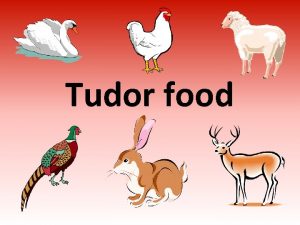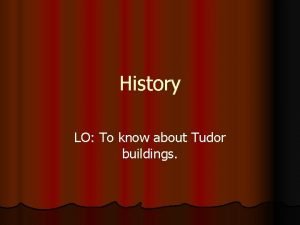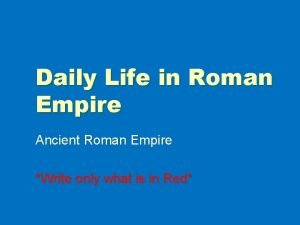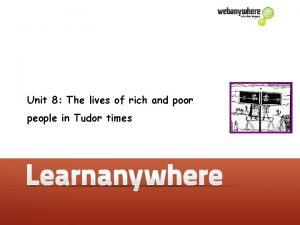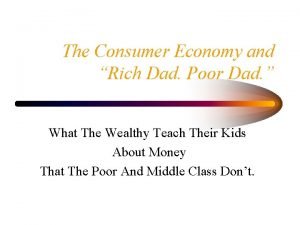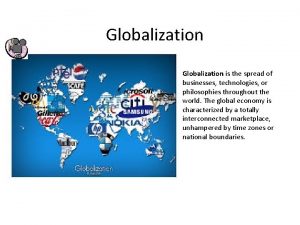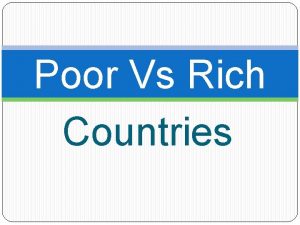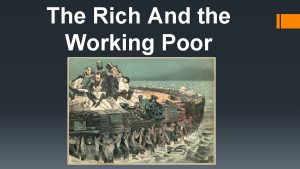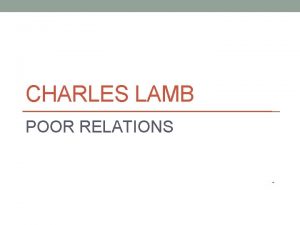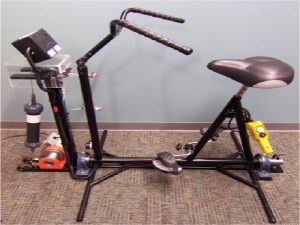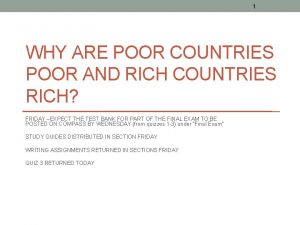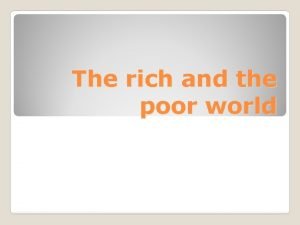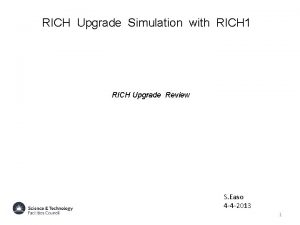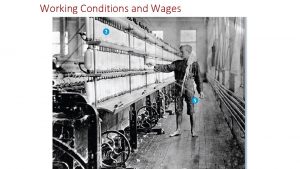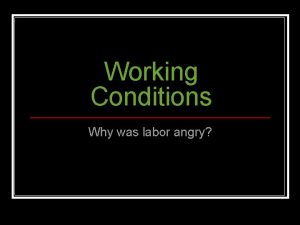The Rich And the Working Poor Working Conditions












- Slides: 12

The Rich And the Working Poor


Working Conditions § § § § Lung damaging dust filled the air Gas explosions were frequent Fires were a common danger Low pay Child labor 13 -14 hour work days with no “breaks” 6 day work week Serious injuries common No fresh air, windows & doors locked. Gas lamps provided light. No laws existed to protect factory workers. Machines were dangerous. Injuries common.

Child Labor § By 1900 2 million minors under age 15 work in dangerous factories throughout the country. § Young miners in Pennsylvania made 38 cents a day. § Worked underground up to 13 hours a day. § Sweatshop - Mostly young women working on sewing machines in filthy and overcrowded factories.

Wages & Labor §Average work week = 60 hours §Typical work day = 12 -14 hours §Average wage for unskilled labor = 10¢/hour §Women paid less and children least §No compensation for injuries

Knights of Labor § In 1869, workers formed a union called the Knights of Labor. § Held secret meetings because employers fired workers that met and joined unions. § In 1879, the union let women, blacks, immigrants, and unskilled workers join. § The goals of the Knights of Labor § shorter workday

American Federation of Labor § The Knights of Labor failed in trying to help workers. § In 1886, Samuel Gompers formed The American Federation of Labor. § Workers did not join the AFL directly. You first had to have your own union, then you could join the AFL. § Used collective bargaining to achieve its goals. Collective bargaining is when unions would negotiate with the management for workers as a group.

The B&O Railroad Strike -1877 § In 1877, the Baltimore and Ohio Railroad cut worker pay by 10%. § Workers in Martinsburg, West Virginia refused to run the trains. § Although this strike was not started by a union, many other cities and other industries joined in. § President Rutherford B. Hayes sent federal troops to stop the violence at these strikes. § During this two week periods, dozens of workers were killed. § This led to other organized strikes which encouraged thousands of workers to join the union.

Haymarket Riot 1886 § A demonstration, in protest of the killing of a striker by the Chicago police. § Nearly 200 policemen arrived to disperse the workers. § unidentified individual threw a bomb at them. § After the explosion and subsequent police gunfire, more than a dozen people lay dead or dying, & almost 100 were injured. § Eight men were convicted § Seven received the death

Homestead Steel Strike § lockout/strike at the Carnegie Steel plant in Homestead PA. § Dispute between the Amalgamated Association of Iron and Steel Workers (the AA) and the Carnegie Steel Company. § Began on June 30, 1892, § Ended in a battle between strikers and private security agents on July 6. § Battle was one of the most serious disputes in U. S. labor history. § A major defeat for the union and a setback for efforts to unionize steelworkers.

Pullman Strike – 1894 § Workers of the Pullman Palace Car Company in Chicago struck to protest wage cuts & the firing of union representatives. § They sought support from the American Railway Union (ARU), led by Eugene V. Debs. § The ARU called a boycott of all Pullman railway cars. 50, 000 rail workers complied & railroad traffic out of Chicago came to a halt. § Railroad owners asked the federal government to intervene. § President Cleveland sent troops to Chicago. Rioting & bloodshed ensued. § The government's actions broke the strike

Triangle Fire - 1911 § March 25, A match or cigarette ignited a fire on the eighth floor of the Triangle Shirtwaist Company in New York City. § Many of the exit doors were locked to prevent employee theft. § 146 people died in the blaze. § Died from the fire, smoke inhalation, or falling or jumping to their deaths. § Most victims were recent Jewish and Italian immigrant women aged
 Why are some countries rich and others poor
Why are some countries rich and others poor Why are some countries rich and others poor
Why are some countries rich and others poor Rich tudor drinks
Rich tudor drinks Rich and poor peter singer
Rich and poor peter singer Poor tudor house
Poor tudor house Tudor rich and poor
Tudor rich and poor Byzantine empire vs roman empire venn diagram
Byzantine empire vs roman empire venn diagram Rich and poor tudors
Rich and poor tudors Tudors food menu
Tudors food menu Relational mindset
Relational mindset Data rich information poor
Data rich information poor Rich dad poor dad expense sheet
Rich dad poor dad expense sheet Poor vs rich
Poor vs rich


